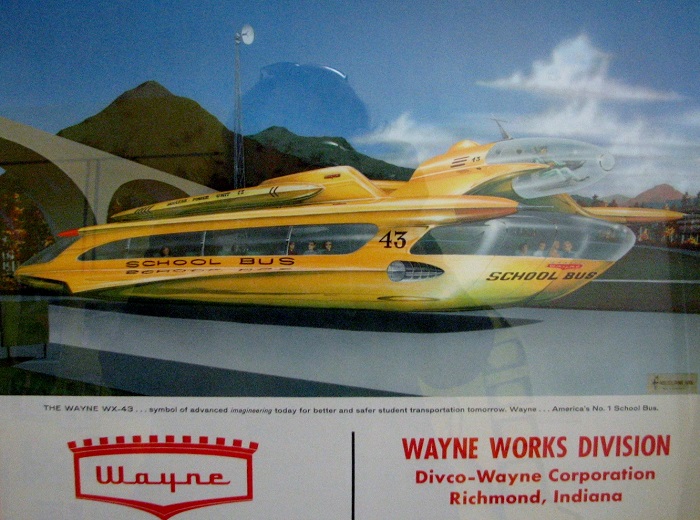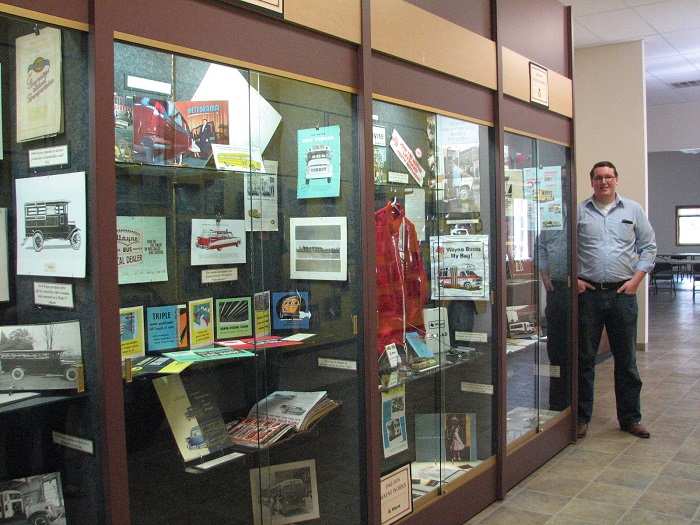Nate Pendergraft is a recent Indiana University East graduate with light brown hair neatly combed to the side. His cowboy boots click on the tile floor as he walks. He leisurely stuffs his hands in his pockets as I study the rotational cases in the Community Room of the Wayne County Historical Museum, near downtown Richmond, Indiana. The cases’ display has been his personal project for several months, and now he’s one of the foremost experts on yet another crown jewel of Richmond’s history: Wayne Works.
Established first as Whitt-Whippo in 1837, Wayne Works moved its facilities to Richmond in 1875. Its entire business model was built on quality vehicles that were both safe and reliable. Wayne Works and its subsidiary company, Miller-Meteor, produced several types of vehicles, including hearses and ambulances, but its specialty was school buses.
Wayne Works philosophy was manifested in one of Nate’s carefully arranged display cases: a scrap-book so large you would have to use both arms to carry it. Inside are hundreds of articles clipped from newspapers. And the common factor? Bus accidents from all around the nation. Nate believes that these articles informed the next generation of school buses. He points to one black and white photograph taken from inside a bus.
‘Rather than having several sheets that could cut a kid in case of an accident’ he said, referring to the metal interior walls, ‘they used one. And these rivets were gone.’
“It was an obsession with child safety. That was the thing they hit the most. Safety. Safety. Safety,” Nate stressed.
Wayne Works was an internationally recognized company. Their buses went to the Vatican and were used on the oil fields in Egypt. One of their ambulance models was used in the 1984 classic, Ghostbusters. At its peak, the company employed 1,600 people and could produce a bus every 10 minutes. Nate’s collection even includes concept drawings of the bus of the future: a double-tiered vehicle that could house the driver in a cockpit separate from the riders to avoid distractions; the bus hovered feet above the ground, looked similar to a bullet train, and featured the classic bus-yellow.
The company did not intend to go out of business, but its downfall began in the mid-80s. An economic recession hit the company especially hard due to the busses’ price tag and manufacturing costs. Poor management in the midst of this caused the company to crash even quicker. There were initial talks of moving the company to Marysville, OH. The day of the auction, however, there were no bidders for the plant. In 1993, the doors finally closed and the 500 employees that remained were dislocated.
These pamphlets, photos, and promotional gear would have been lost; when the building was bought by Carpenter Building Company in 1995, everything that remained was thrown in the dumpster. Staff from the museum dug it out once they heard. For years, this material sat in the museum’s basement until Eugene Cruz-Uribe, a board member of the Wayne Historical Society and history professor at Indiana University East, decided to engage his students in local history. Here’s where Mr. Pendergraft steps in.
Cruz-Uribe assigned this project to Nate for his Capstone, the course every student must pass in order to receive a Bachelor’s degree in his or her discipline. So, Nate dug through 12 boxes of the recovered items for over 300 hours—three hours a week during the Spring semester and 20 hours a week over the summer. His display will remain for another 6 months to a year, and when it’s finished, it should fill just 2 boxes of the original 12. Photos of this display will be placed in the boxes so that when it has rotated through Vietnam or Korea or Natco, staffers 20 years from now will know how to set them up.
I comment on the power he has been given to alter history. Nate says that it was in his power, but he wants to be a fair historian. His special interest is the British Empire in South Africa, specifically the Anglo-Zulu war. This is his first curative experience, but he hopes it will not be the last.
Special thanks to Wayne County Historical Museum Executive Director Jim Harlan and the museum staff for their support of IU East student projects.
* If you would like to learn more, visit waynecountyhistoricalmuseum.org/ for hours of operation and upcoming events.
** Are you interested in a curricular or co-curricular service project? The Center for Service Learning can help you connect! iueastsl@iue.edu
Kaylyn Nicole Flora is a special projects assistant at the IU East Campus Library. She is a 2015 graduate of IU East with Bachelor’s Degrees in English, with a concentration in Creative Writing, and Fine Arts.





